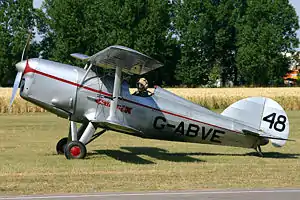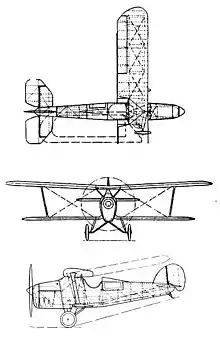Arrow Active
The Arrow Active is a British aerobatic aircraft built in the 1930s.
| Active | |
|---|---|
 | |
| Arrow Active 2 | |
| Role | Aerobatic sports aircraft |
| Manufacturer | Arrow Aircraft Ltd. |
| Designer | A. C. Thornton |
| First flight | 1931 |
| Number built | 2 |
Design and development
The Arrow Active is a single-seat biplane of conventional configuration, with single-bay, staggered wings of unequal span and chord, bordering on being a sesquiplane. The upper and lower wings are joined by a single interplane strut. The undercarriage is fixed, with a pair of mainwheels and a tail-skid. It was originally powered by a 115 hp (86 kW) Cirrus-Hermes IIB engine.
The second aircraft built featured a more powerful 120 hp (90 kW) de Havilland Gipsy III and was designated Active 2. It also differed from the Active 1 in having a strutted, conventional centre section, a slightly different shaped fin and rudder, and smaller, wider wheels.
Operational history
Although it was originally hoped[1] that the military might show an interest in the aircraft, this did not transpire, and the Active was flown as a sports plane. The Active 1 G-ABIX received its Certificate of Airworthiness on 21 May 1931[2] and flew at 132.2 mph (212 km/h) in the 1932 King's Cup Race. It was Alex Henshaw's mount in the second half of 1935 until severely damaged in a crash following an in-flight fire that December.
The Active 2 G-ABVE was certified on 29 June 1932[3] and flew in the King's Cup in both 1932 and 1933. Slightly faster than the Arrow 1, it recorded a speed of 137 mph (220 km/h)
Variants
- Active 1
- One aircraft powered by a 115hp (86kW) Cirrus Hermes IIB engine.
- Active 2
- One aircraft powered by a 120hp (90kW) de Havilland Gipsy III engine, rebuilt in 1958 with a de Havilland Gipsy Major 1C.[4]
Surviving aircraft
Rebuilt in 1958, and again in 1989, the Active 2 is still on the British civil register and is based at Coventry, England.[5]
Specifications (Active 2)

Data from [6]
General characteristics
- Crew: one pilot
- Length: 18 ft 10 in (5.74 m)
- Wingspan: 24 ft 0 in (7.32 m)
- Height: 7 ft 3 in (2.21 m) [7]
- Wing area: 120 sq ft (11.2 m2) [7]
- Empty weight: 925 lb (420 kg)
- Gross weight: 1,325 lb (600 kg)
- Powerplant: 1 × de Havilland Gipsy III inverted inline engine , 120 hp (80 kW)
Performance
- Maximum speed: 144 mph (230 km/h, 125 kn)
- Cruise speed: 128 mph (206 km/h, 111 kn)
- Range: 420 mi (676 km, 360 nmi) [7]
References
Notes
- Flight 1931, 727
- Jackson 1959, page 407; Jackson 1973, page 286
- Jackson 1959, page 408; Jackson 1973, page 287
- UK CAA/G-INFO
- of aircraft/G-INFO/ https://www.caa.co.uk/register of aircraft/G-INFO/.
{{cite web}}: Check|url=value (help); Missing or empty|title=(help) - Jackson 1959 pp.407-8; Jackson 1973 pp.206-7
- Ord-Hume 2000, pp. 234
Bibliography
- Ord-Hume, Arthur W.J.G. (2000). British Light Aeroplanes. Peterborough: GMS Enterprises. ISBN 1-870384-76-8.
- Jackson, A.J. (1959). British Civil Aircraft 1919-59, volume 1. London: Putnam and Co. Ltd.
- Jackson, A.J. (1973). British Civil Aircraft since 1919 Volume 1. London: Putnam. ISBN 0-370-10006-9.
- "The Arrow "Active"". Flight: 727–28. 24 July 1931. Retrieved 24 September 2008.
- Taylor, Michael J. H. (1989). Jane's Encyclopedia of Aviation. London: Studio Editions.
- World Aircraft Information Files. London: Bright Star Publishing.